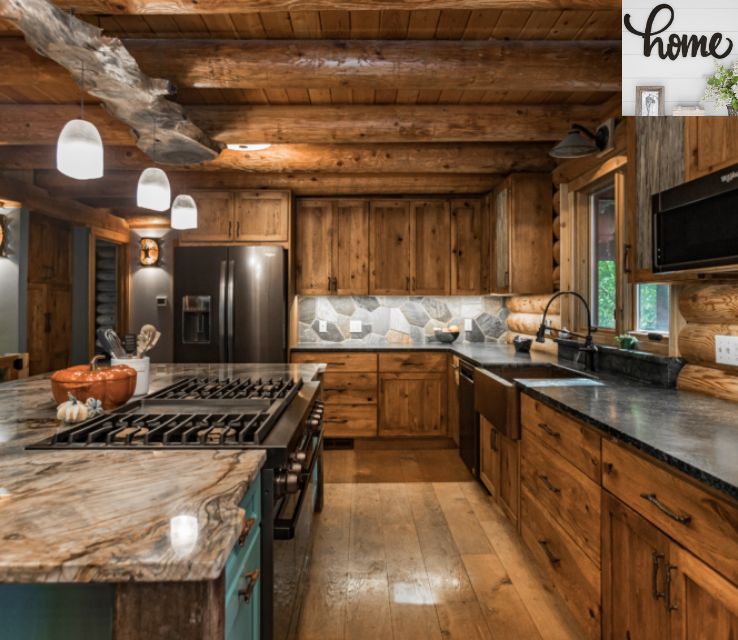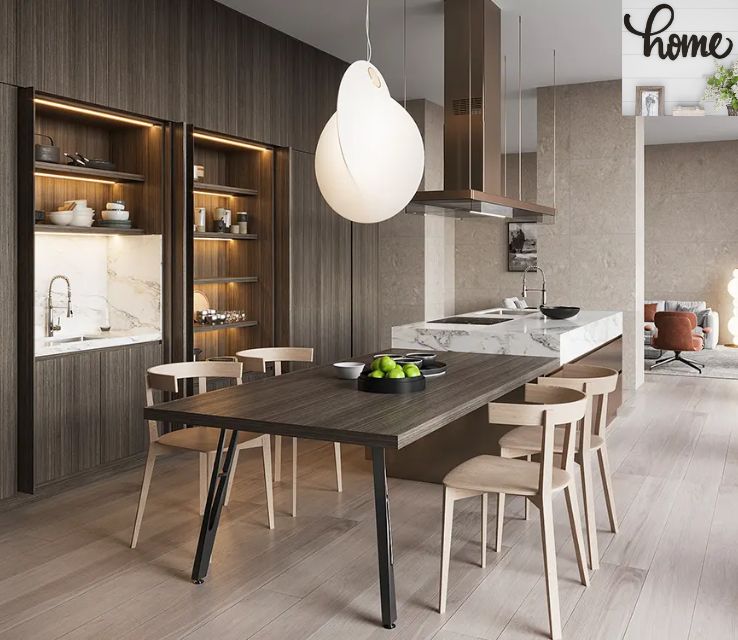A kitchen where rustic charm meets contemporary elegance, this is the essence of a Modern Rustic Kitchen. With its unique blend of natural materials and streamlined design, this style has become increasingly popular among homeowners looking to create a warm yet functional space.
We will delve into the key features that make up a kitchen, providing you with valuable insights to help you achieve a perfect balance of coziness and sophistication in your own home.
What Defines a Modern Rustic Kitchen?
A kitchen is rooted in contrast, creating a harmonious blend of the old and new. This design aesthetic juxtaposes raw, organic materials such as reclaimed wood, natural stone, and metal finishes with sleek lines and minimalist décor. Imagine a weathered wooden island paired with stainless steel appliances, this interplay not only highlights the beauty of each element but also infuses the space with warmth and personality.
A kitchen seamlessly marries the charm of traditional aesthetics with contemporary functionality, creating a warm and inviting space. Central to this design is the use of natural materials like reclaimed wood, which not only adds character but also tells a story through its unique imperfections.

Exposed beams and stone backsplashes introduce an earthy texture that grounds the kitchen, while neutral color palettes dominated by whites, grays, browns, and blacks provide a clean canvas that enhances the natural elements.
Incorporating modern appliances into this rustic framework is essential for ensuring efficiency without sacrificing style. These appliances are often cleverly integrated to maintain a cohesive look, allowing handcrafted elements such as butcher block counters or open wood shelving to take center stage.
1. Embrace Natural Materials
Reclaimed wood is a cornerstone of rustic design, infusing spaces with a sense of authenticity and character. Imagine barn style cabinetry that echoes the charm of old farmhouses, or exposed ceiling beams that create a striking visual contrast against sleek modern appliances.
A vintage wood island can serve as the centerpiece of your kitchen, inviting family and friends to gather around while also telling a story of its own. This combination of new and old not only adds warmth but also fosters an inviting atmosphere that feels both lived-in and luxurious.
2. Focus on a Neutral, Earthy Palette
In a kitchen, the color scheme should feel calm and grounded, creating a serene environment that encourages culinary creativity. Soft whites and creamy beiges serve as a timeless foundation, while deep browns and charcoal grays add layers of sophistication.
Incorporating natural wood tones whether light oak, rich walnut, or weathered barnwood enhances the organic feel of the space, connecting it to the surrounding nature. This earthy palette not only evokes a sense of warmth but also invites the outdoors in, making the kitchen a welcoming hub for family and friends.
3. Mix Old and New
The heart of the modern rustic style is the blending of eras, creating a dynamic kitchen space that feels both timeless and current. Pairing vintage elements — like a farmhouse sink, antique bar stools, or retro signage with the latest stainless steel or matte black appliances results in a captivating contrast that draws the eye.
This juxtaposition not only enhances visual interest but also tells a story, weaving together the charm of the past with the sleekness of modern design.
4. Prioritize Open Layouts and Natural Light For Rustic Kitchen
Rustic kitchens often feel open and airy, a trait emphasized in modern designs as well. By choosing an open floor plan that seamlessly connects the kitchen with dining or living areas, homeowners can foster a sense of community and interaction.

This layout not only encourages socializing but also allows for a more versatile use of space, perfect for both intimate family gatherings and larger entertaining events.
5. Add Statement Lighting
Lighting is a key element that can define the look of a kitchen, transforming it from merely functional to a warm and inviting gathering space. Oversized pendant lights with iron, copper, or distressed finishes introduce an industrial flair that complements natural materials like reclaimed wood and stone.
These bold fixtures act as focal points, drawing the eye upward and creating a visual balance in the design. Pairing these with Edison bulbs not only enhances the aesthetic but also infuses a nostalgic farmhouse feel that resonates with contemporary sensibilities.
6. Use Functional and Stylish Furniture
Furnishings in a kitchen should be both functional and stylish, seamlessly blending practicality with aesthetic appeal. A reclaimed wood dining table paired with sleek, contemporary chairs not only creates a striking visual contrast but also serves as a gathering point for family and friends.
This combination emphasizes the warmth of natural materials while maintaining a polished look that complements modern design elements.
7. Keep Decor Simple but Meaningful
In a kitchen, simplicity doesn’t have to mean blandness. While it’s essential to avoid clutter, don’t shy away from infusing personality into the space. A few curated items can significantly enhance your kitchen’s charm, such as vintage cookware that tells a story or ceramic bowls that add a splash of color.
Framed prints of serene countryside scenes can serve as visual focal points, inviting warmth and nostalgia into the room. Similarly, woven baskets can not only hold everyday essentials but also contribute texture and an artisanal feel to the overall design.
8. Incorporate Eco-Friendly Design
A kitchen naturally leans toward sustainability, making it an ideal choice for environmentally conscious homeowners. By incorporating reclaimed materials such as salvaged wood for cabinets or countertops, you not only add character and history to your space but also minimize waste and reduce the demand for new resources.
Pairing these elements with energy efficient appliances can significantly lower your household’s carbon footprint, showcasing a commitment to both aesthetic appeal and ecological responsibility.
Read More: 10 Stunning New Lake House Decor Ideas for 2025!
Conclusions
The Modern Rustic Kitchen effortlessly blends the charm of traditional design with contemporary aesthetics. By incorporating natural materials, warm color palettes, and functional layouts, homeowners can create a space that feels both inviting and stylish.
This design style not only enhances the visual appeal of the kitchen but also promotes a sense of comfort and connection to nature. Whether you’re renovating your existing kitchen or designing a new one, embracing modern rustic elements can transform your culinary space into a true heart of the home.
FAQs
What colors work best in a modern rustic kitchen?
Neutral tones like whites, grays, browns, and blacks work best. Wood tones and natural hues add warmth and contrast, while small accents of greenery or matte metallics complete the look.
Can I use modern appliances in a rustic kitchen?
Modern appliances are a key element of the modern rustic style. Choose appliances in stainless steel, black, or integrated designs that blend with cabinetry for a cohesive look.
How can I make my small kitchen feel rustic and modern?
Use open shelving to create a sense of space, add reclaimed wood accents for rustic charm, and stick to a light neutral palette. Incorporate sleek hardware and lighting for a modern edge.
What type of flooring suits a modern rustic kitchen?
Natural wood, wide plank hardwood, stone tiles, or even concrete floors work beautifully. Choose finishes that enhance the natural texture and tone of the materials.
Is the modern rustic style expensive to achieve?
Salvaged or reclaimed materials can be budget-friendly, and mixing high-end finishes with vintage or DIY elements can balance the cost. Focus on quality over quantity and highlight materials with character.
